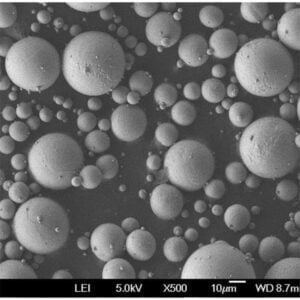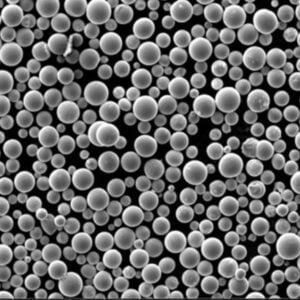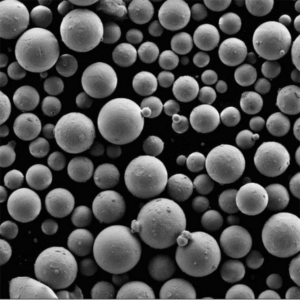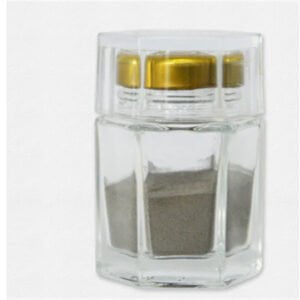Prášky z kovových slitin
Obsah
Prášky z kovových slitin refer to particulate blends of two or more metal elements used across manufacturing, additive techniques and research applications. This guide serves as an in-depth reference on metal alloy powders – exploring types, production methods, key properties, specifications, suppliers, pricing, applications, comparisons and more.
Overview of Metal Alloy Powders
| Charakteristický | Popis |
|---|---|
| Složení | Metal alloy powders are finely divided metallic particles created by breaking down a combination of two or more metals into a powder form. These alloys are engineered to achieve specific properties like enhanced strength, corrosion resistance, or conductivity that individual metals may not possess on their own. |
| Výrobní proces | Metal alloy powders are produced through various techniques, with atomization being the most common. In atomization, the molten alloy is broken into a fine mist of droplets that rapidly solidify into spherical or near-spherical powder particles. Other methods include electrolysis, solid-state reduction, and mechanical milling, each offering advantages for specific materials or applications. |
| Vlastnosti částic | The size, shape, and distribution of the metal alloy powder particles significantly impact the final properties of the parts they are used to create. Spherical particles generally flow better and pack more densely, leading to improved performance in additive manufacturing processes like 3D printing. Particle size can also influence the mechanical properties, surface finish, and overall quality of the final product. |
| Aplikace | Metal alloy powders have revolutionized manufacturing across various industries. They are extensively used in additive manufacturing (3D printing) to create complex, lightweight components for aerospace, automotive, and medical applications. Additionally, metal alloy powders are employed in processes like metal injection molding (MIM) to produce intricate near-net-shape parts for various applications. |
| Výhody | Compared to traditional manufacturing methods like machining or casting, metal alloy powders offer several advantages. They enable near-net-shape manufacturing, minimizing material waste. Additionally, the ability to tailor the composition and particle characteristics of the powder allows for the creation of parts with specific properties. Metal alloy powders also facilitate the production of complex geometries and lightweight structures, making them ideal for various cutting-edge applications. |
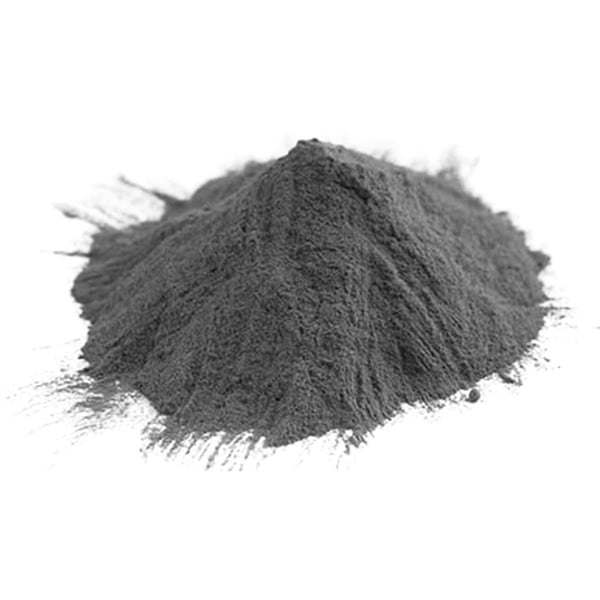
Metal Alloy Powder Types
Major Categories:
- Steel alloys – stainless, tool, alloy steels…
- Slitiny titanu – Ti6Al4V, TiAl, titanium aluminides
- Slitiny hliníku – aluminum 2024, 7075, AlSiMg
- Kobaltové slitiny – cobalt chrome, MP35N
- Slitiny niklu – Inconel 625, Inconel 718, Hastelloys
And uniqueness based on:
Legující prvky
| Typ | Common Elements | Example Materials |
|---|---|---|
| Low Alloy | <5% Ni, Cr, Mo | 4140, 4340 |
| Medium Alloy | 5-15% Ni, Cr, Mo etc. | H13, 420 stainless |
| High Alloy | 15-30% Al, Co, Ti etc. | 316 stainless, MP35N |
Způsob výroby
| Metoda | Alloy Systems | Charakteristika |
|---|---|---|
| Rozprašovaný plyn | Většina slitin | Spherical, controlled size distribution |
| Atomizovaná voda | Ocel | Irregular shape, wide distribution |
| Plazmová atomizace | Reactive materials like Ti & Al alloys | Controlled atmosphere, spherical |
| Elektrolytické | Copper, Ni | Dendritic flakes, sponge |
Blending elements like aluminum, cobalt, chromium, tungsten etc. with base metals produces enhanced alloy powder capabilities. Production technique also influences powder morphology and traits.
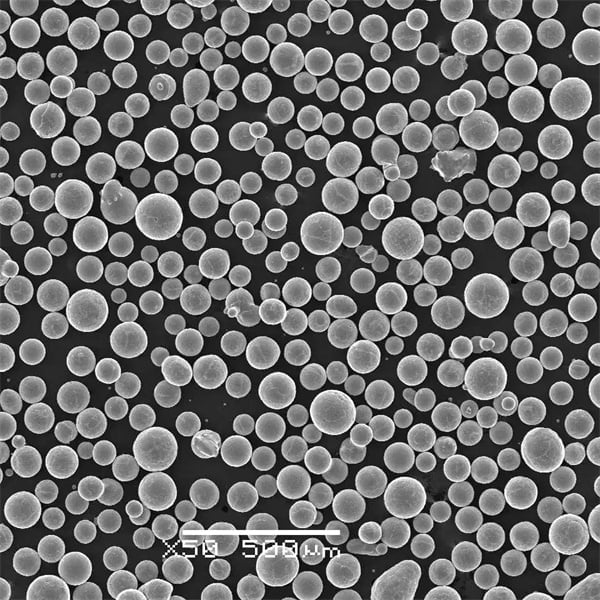
Metal Alloy Powder Manufacturing Processes
| Proces | Popis | Výhody | Nevýhody | Aplikace |
|---|---|---|---|---|
| Atomizace | The most common method, atomization involves melting the metal alloy and then breaking it into a fine mist of droplets using a high-pressure gas (gas atomization) or a rapidly spinning disc (centrifugal atomization). The droplets solidify rapidly as they fall in a controlled atmosphere, creating spherical or near-spherical powder particles. | High production rate Tailorable particle size and distribution Suitable for a wide range of alloys | Vysoká spotřeba energie Potential for oxidation during atomization May require additional processing for specific shapes | Ozubená kola Ložiska Řezné nástroje Letecké komponenty Lékařské implantáty |
| Elektrolýza | This process uses an electric current to extract metal ions from a metal salt solution and deposit them on a cathode ( negatively charged electrode) as a fine powder. The specific properties of the powder can be controlled by adjusting the electrolyte composition and deposition parameters. | Prášky vysoké čistoty Excellent control over particle size and morphology Suitable for reactive metals | Relatively slow process Limited production rate Vysoká spotřeba energie | Elektrické kontakty Battery components Filters Specializované slitiny |
| Redukce pevných látek | In this method, a metal oxide is directly converted to a metal powder through a reduction reaction with a reducing agent like hydrogen or carbon monoxide at elevated temperatures. Solid-state reduction is often used for metals with high oxygen affinity, such as titanium and zirconium. | Suitable for reactive metals Can be a continuous process Potentially lower energy consumption compared to atomization | Limited control over particle size and morphology May require additional post-processing steps Potential for contamination from the reducing agent | Pyrotechnika Vstupní suroviny pro vstřikování kovů Třecí materiály |
| Chemická redukce | This process involves using a chemical reaction to convert a metal compound into a metal powder. Different chemical reactions can be employed depending on the specific metal and desired powder characteristics. | Can be used for a variety of metals Relatively simple process Potential for low-cost production | Limited control over powder properties May require extensive purification steps Environmental concerns associated with some chemical reactants | Catalyst supports Pigmenty Pájení slitin |
| Mechanické frézování | This method involves grinding bulk material (ingots, chips) into a fine powder using high-energy mills. Mechanical milling can be used to produce powders from a wide range of materials, including metals, alloys, and ceramics. | Versatility – applicable to various materials Can be used for small batch production | Broad particle size distribution Potential for contamination from milling media Heat generation during processing can affect powder properties | Amorphous metal powders Composite materials Speciální slitiny |
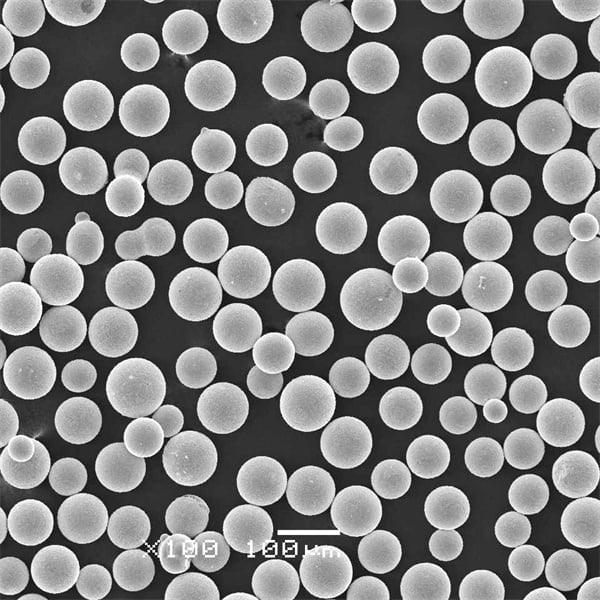
Vlastnosti Prášky z kovových slitin
Fyzikální vlastnosti
| Atribut | Charakteristika |
|---|---|
| Stát | Solid Particulate Powder |
| Barva | Greyish silver/black powder |
| Magnetismus | Ferritic/martensitic materials are ferromagnetic |
| Zápach | Typically odorless |
| Taste | Tasteless |
| Rozpustnost | Insoluble in water and common solvents |
Mechanické vlastnosti
| Metrický | Popis |
|---|---|
| Tvrdost | Range from soft precious alloys < 100 HV to hardened tool steels > 700 HV |
| Síla | Span from < 100 MPa for plain carbon steels to over 2,000 MPa for some nickel superalloys |
| Tažnost | Measure of malleability – high for C steel, medium in work steels, low in high Cr/Co materials |
Tepelné vlastnosti
| Opatření | Podrobnosti |
|---|---|
| Bod tání | Dependent on alloy system – 500 to 1500°C+ |
| Tepelná vodivost | 15 – 90 W/mK between alloy types |
| CTE | Varies from ~5 x10-6 K-1 (Invar) to ~18 x10-6 K-1 (aluminum alloys) |
Tabulka 2: Overview of common metal alloy powder physical, mechanical and thermal properties
Specific alloy choice balances hardness, yield strength, ductility, density, heat/corrosion resistance and other attributes as per application.
Specifikace
Commercial metal alloy powders are tested and certified to specifications:
Distribuce velikosti částic
| Standard | Mikrony | Způsob výroby |
|---|---|---|
| Pokuta | 1-25 | Rozprašování plynu |
| Střední | 25-75 | Rozprašování plynu |
| Hrubý | 75-150 | Rozprašování vody |
Stupně čistoty
| Hodnocení | Chemistry Control | Nečistoty |
|---|---|---|
| Standard | Broad alloy ranges | Up to 1% other |
| Vlastní | Fixed alloy target | <1000 ppm impurities |
| Vysoká čistota | Tight alloy band | <100 ppm contaminants |
Tabulka 3: Typical size ranges, chemistry and purity grades for commercial metal alloy powders
Meeting or exceeding certified specifications ensures repeatable performance between powder lots and downstream production runs.
Metal Alloy Powder Manufacturers
| Manufacturer Category | Popis | Klíčové produkty | Applications Served | Geographic Reach |
|---|---|---|---|---|
| Global Leaders | These multinational corporations possess extensive production capabilities, diverse metal alloy offerings, and advanced research & development programs. They cater to a wide range of industries and often operate manufacturing facilities across several continents. | Nickel, iron, cobalt-based superalloys Titanium and aluminum alloys Specialty alloys for additive manufacturing | Aerospace & Defense (turbine blades, engine components) Oil & Gas (drilling equipment, downhole tools) Automotive (gears, bearings) Medical ( implants, prosthetics) Electronics (heat sinks, electrical contacts) | Severní Amerika Evropa Asia Jižní Amerika |
| Regional Players | These manufacturers focus on specific geographic markets and cater to regional industry needs. They may specialize in particular alloys or cater to niche applications. | Prášky z nerezové oceli Nástrojové oceli Brass and bronze powders Surovina pro vstřikování kovů (MIM). | Consumer goods (cutlery, hardware) Industrial machinery components Elektrické komponenty Automotive parts (gears, filters) Medical devices (surgical instruments) | Severní Amerika Evropa Asia (May have a limited presence in other regions) |
| Emerging Manufacturers | These companies are often smaller and focus on innovative technologies or cater to new market demands. They may specialize in additive manufacturing (AM) powders or explore novel production methods. | High-performance metal powders for AM Nanopowders for specialized applications Metal alloy powders from recycled materials Biocompatible alloys for medical implants | Additive manufacturing industry Emerging technologies (e.g., 3D printing for aerospace) Research and development institutions Environmental sustainability initiatives | Primarily focused on developed regions (North America, Europe, Asia) but may expand globally with market growth |
| Contract Manufacturers | These manufacturers produce metal alloy powders based on customer specifications. They offer flexibility in terms of alloy composition, particle size, and production volume, catering to specific applications and research needs. | Custom metal alloy powders Malosériová výroba Powders for prototyping and pilot projects | Research & development in various industries Additive manufacturing projects requiring unique materials Specialized applications in aerospace, medical, and electronics industries | Global reach (can be located anywhere but often present in major manufacturing hubs) |
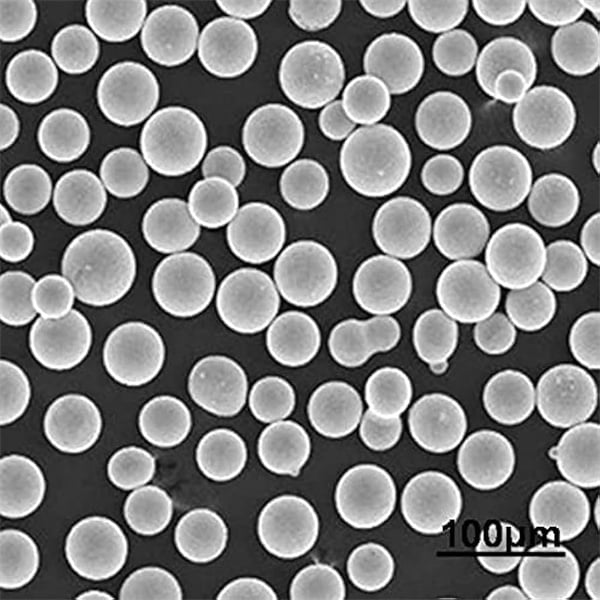
Aplikace z Prášky z kovových slitin
| Průmysl | Aplikace | Výhody |
|---|---|---|
| Aerospace | Turbine blades, airframe components | High strength, heat resistance |
| Automobilový průmysl | Gearing, powertrain parts | Wear protection |
| Výrobní | Custom product tooling | Shorter development cycles |
| Ropa a plyn | Seals, valve components, well tools | Durability improvements |
Tabulka 5: Metal alloy powder enables high performance applications across sectors
Leveraging properties like heat tolerance, hardness and corrosion resistance facilitates reliability in demanding equipment environments over incumbent alternatives like plastics or traditional alloys.
Pros and Cons of Metal Alloy Powders
| Klady | Nevýhody |
|---|---|
| Flexibilita designu: Metal alloy powders enable the creation of complex geometries with intricate features that are difficult or impossible to achieve with traditional manufacturing methods like machining or casting. This opens doors for lightweight and high-performance components in various industries. | Omezená velikost dílu: Current powder-bed 3D printing technologies have limitations on the maximum printable part size. Additionally, larger parts may require post-processing steps like hot isostatic pressing (HIP) to improve mechanical properties, adding complexity and cost. |
| Účinnost materiálu: Metal alloy powders promote near-net-shape manufacturing, minimizing material waste compared to subtractive techniques like machining. This is particularly beneficial for expensive or high-performance alloys. | Vyšší náklady: Metal alloy powders themselves can be more expensive than bulk metals due to the additional processing involved in their production. Additionally, 3D printing equipment and post-processing steps can contribute to higher overall manufacturing costs, especially for low-volume production. |
| Vlastnosti na míru: The properties of metal alloy powders can be precisely controlled through adjustments in the manufacturing process and alloy composition. This allows for the creation of materials with specific strength, weight, corrosion resistance, or other desired characteristics. | Povrchová úprava: The surface finish of parts produced from metal alloy powders can be rougher compared to machined or cast components. Post-processing techniques like polishing or machining may be necessary to achieve a desired surface quality. |
| Lehký design: Metal alloy powders facilitate the creation of lightweight structures with high strength-to-weight ratios. This is crucial for applications in aerospace, automotive, and other weight-sensitive industries. | Anizotropie: Parts printed with metal alloy powders can exhibit anisotropic properties, meaning their mechanical strength can vary depending on the printing direction. This needs to be considered during the design phase to ensure optimal performance. |
| Rychlé prototypování: Metal alloy powders are ideal for rapid prototyping of complex parts. This allows for faster design iterations and quicker time-to-market for new products. | Obavy o bezpečnost: Handling metal alloy powders can pose safety hazards due to potential flammability, inhalation risks, and skin irritation. Proper handling procedures and personal protective equipment are essential. |
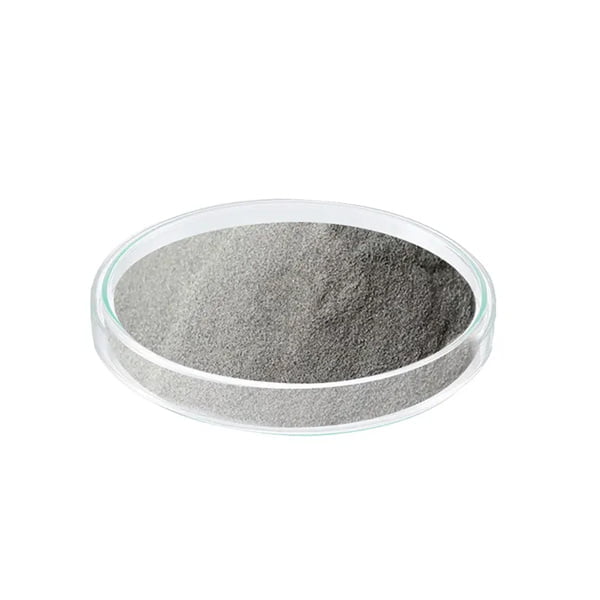
Nejčastější dotazy
Q: What is the main difference between metal alloy ingots versus powders?
A: Powders impart refined, segregation-free microstructures and provide feedstock for emerging manufacturing techniques. Ingots serve conventional forming processes.
Q: Which metal alloy powder is expected to see the most growth in coming years?
A: Titanium and aluminum alloy powders for aerospace applications given exceptional strength-to-weight capabilities and processability.
Q: What particle size range works best for common metal alloy AM processing?
A: 15-45 microns provides good powder bed packing density and layerwise cohesion while avoiding challenges seen with ultrafine powders.
Q: How are metal alloy powders different from metal oxide or ceramic powders?
A: Metal alloy powders contain 2+ metallic elements forming substitutional mixes while oxides/ceramics involve ionic chemistry changes with profoundly different properties.
Závěr
Optimized metal alloy powder compositions, microstructures and morphologies extends part fabrication, prototyping and performance possibilities across aviation, space, automotive and energy sectors – as documented here through property insights, manufacturing guidance, specification parameters and application examples. Please reach out with any other questions surrounding specialty alloy selection, procurement or processing.
Sdílet na
MET3DP Technology Co., LTD je předním poskytovatelem řešení aditivní výroby se sídlem v Qingdao v Číně. Naše společnost se specializuje na zařízení pro 3D tisk a vysoce výkonné kovové prášky pro průmyslové aplikace.
Dotaz k získání nejlepší ceny a přizpůsobeného řešení pro vaše podnikání!
Související články

Vysoce výkonné segmenty lopatek trysek: Revoluce v účinnosti turbín díky 3D tisku z kovu
Přečtěte si více "O Met3DP
Nedávná aktualizace
Náš produkt
KONTAKTUJTE NÁS
Nějaké otázky? Pošlete nám zprávu hned teď! Po obdržení vaší zprávy obsloužíme vaši žádost s celým týmem.

Kovové prášky pro 3D tisk a aditivní výrobu
SPOLEČNOST
PRODUKT
kontaktní informace
- Město Qingdao, Shandong, Čína
- [email protected]
- [email protected]
- +86 19116340731






